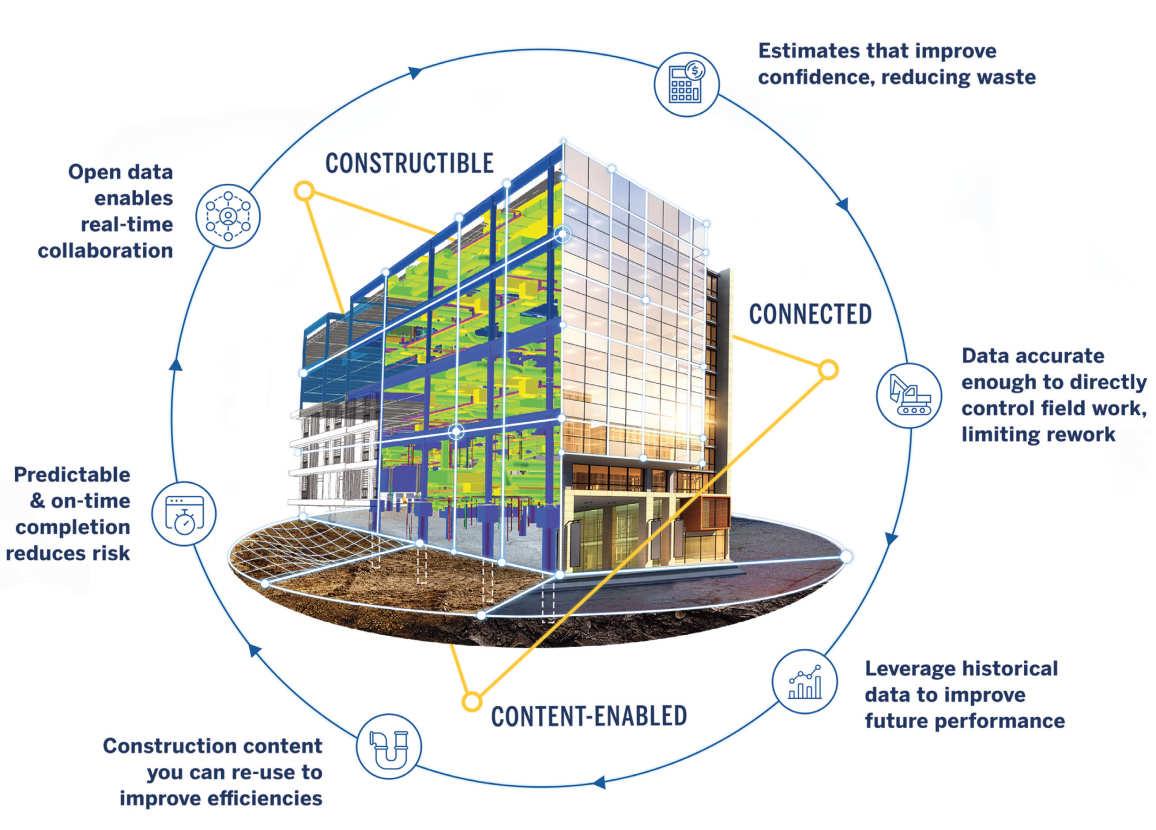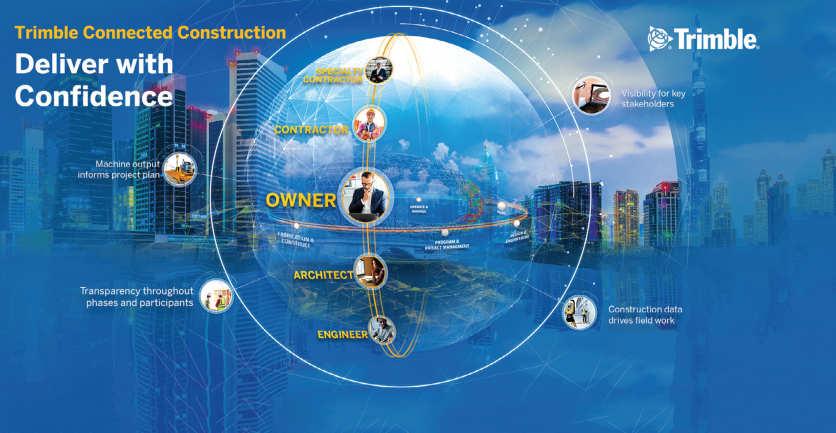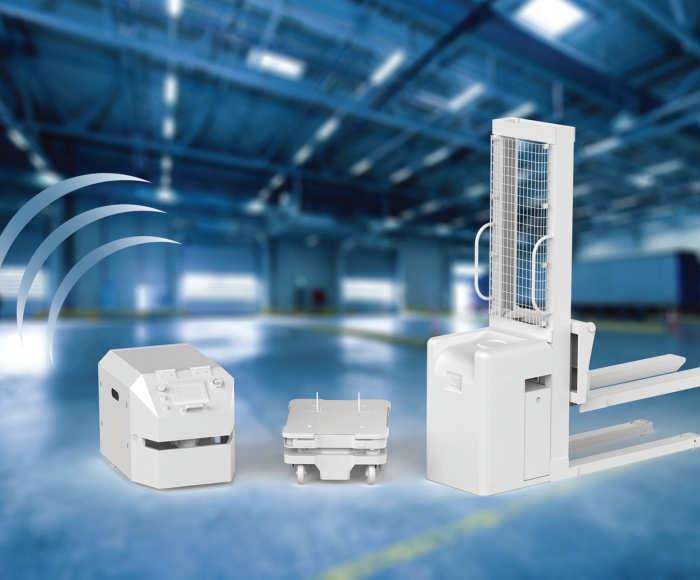
10 minute read
Digital Twins
Photo Credit : Trimble
Trimble Connected Construction.
Transforming cities and the future of construction with Digital Twins
Trimble talks to Technical Review Middle East on cutting-edge technologies that are enabling a number of industries to build resilience and achieve objectives that were previously impossible.
DIGITAL TWINS, ONE of the emerging trends today, are supporting several large and complex projects in ensuring better and more efficient workflows. This makes it crucial to comprehend Digital Twins and their applications, which have the potential to transform cities and the future of construction.
As a leading digital construction solutions provider, Trimble defines Digital Twin, also known as Data Twin, as a digital representation of a realworld physical object. Outside of the built environment, Digital Twins are used in a variety of industries, including healthcare, aerospace, and systems engineering. Essentially, a Digital Twin in construction is the exact digital representation of a construction project or asset, be it a building or group of buildings, bridge, highway, city block, or even an entire city.
Digital Twins are produced by compiling and combining realworld data about the

structure or building using tools like 3D laser scanners, drones, sensors, cameras, and other IoTrelated devices. They can give stakeholders a deeper understanding of their asset in realworld conditions and can learn from multiple sources and automatically update to reflect the changes made to its realworld counterpart, with the support of IoT and AI. This includes the flow of energy, design changes, environmental conditions, the properties of its materials, and security threats.
There are a number of projects in the Middle East that have made use of Digital Twins. For instance, the innovative technology was used during the Expo 2020 Dubai, to create a Digital Twin of the site for better structural planning. In the EXPO city, the creative architectural design and structural path are evident today. Digital Twins are also changing cities like NEOM, which is the Kingdom of Saudi Arabia's USD 500 billion hightech city. The Digital Twins technology is supporting the development of this new space, which combines physical architecture, hyperconnected technologies, and artificial intelligence. Additionally, Dubai Municipality announced plans to collaborate with private sector companies and investors to create a Digital Twin of the city in the Metaverse, referred to as ‘One Human Reality.’

Specialised software such as Trimble Connect, Quadri, Agile Assets, or Tekla offer project stakeholders a centralised, single source of information.
Digital Twins are produced by compiling and combining realworld data about the structure or building using tools like 3D laser scanners, drones, sensors, cameras, and other IoTrelated devices.
Paul Wallett, regional director of Trimble Solutions, Middle East and India, said, “In the construction industry, Digital Twins help improve the analytical capabilities of Building Information Modelling (BIM). With Digital Twin integration, construction teams can easily monitor, update, and predict tasks, allowing them to work smarter. Project owners and managers can reconstruct every metric of a physical structure in a digital environment, experiment digitally, as well as analyse outcomes before making changes that affect the actual structure.”
“By converting 3D models to Digital Twins, users can improve their analytical capabilities across the entire construction process. In addition to making onthespot data collection and design verification easier and less resourceintensive, Trimble’s solutions improve the efficiency of digital models by ensuring that they accurately represent their realworld counterparts,” he added.
NASA's Apollo 13 mission in 1970 was the first to use data twins, despite its unpopularity at the time. Today, an entire city can be digitally modelled for planning purposes, including population growth and climate change modelling for accurate information. These models, which can track, store, and display complex data instantly, aid in providing useful, comprehensive information across all phases of construction to boost planning and operational efficiency.
The adoption of effective technologies and their applications are essential for the construction industry to thrive. Trimble provides businesses and cities with the right technology required to enhance construction activities and streamline operations through its advanced suite of solutions. Digital Twins can be accessed through specialised software, such as Trimble Connect, Quadri, Agile Assets, or Tekla. These systems offer project stakeholders a centralised, single source of information relating to digital twin storage and sharing. As a result of these new trends and advancements, the industry can look forward to more intricately designed structures that are developed with improved efficiency. ■
Moving forward with AI
As mobile robots become more popular, it is important to understand the major challenges and benefits they provide.
MOBILE ROBOTS HAVE seen a rise in popularity in many areas, from warehouses to hospitals and even on the street. Their popularity is easy to understand – they are cheaper, safer, easier to find, as compared to actual workers. They are also easy to scale or combine with other machines. As mobile robots collect a lot of realtime data, companies can use them to start their IIoT journey.
What are Mobile Robots?
Mobile robots transport materials from one location to another and come in two types, automated guided vehicles (AGVs) and autonomous mobile robots (AMRs). AGVs use guiding infrastructure (wires reflectors, reflectors, or magnetic strips) to follow predetermined routes. If an object blocks an AGV's path, the AGV stops and waits until the object is removed.
AMRs are more dynamic. They navigate via maps and use data from cameras, builtin sensors, or laser scanners to detect their surroundings and choose the most efficient route. If an object blocks an AMR's planned route, it selects another route. As AMRs are not reliant on guiding infrastructure, they're quicker to install and can adapt to logistical changes.
However, to work efficiently, mobile robots need safe and reliable communication. Manufacturers can face certain challenges in keeping mobile robots operational and working effectively.
Establish a wireless connection
The first challenge for mobile robot manufacturers is to select the most suitable wireless technology. The usual advice is to establish the requirements, evaluate the standards, and choose the best match. Unfortunately, this isn't always possible for mobile robot manufacturers as often they don't know where the machine will be located or the exact details of the target application.
In some situations, a Bluetooth connection will be ideal as it offers a stable noncongested connection, while other applications will require a highspeed, secure cellular connection. It would be useful for mobile robot manufacturers to have a networking technology that's easy to change to meet specific requirements.
The second challenge is to ensure that the installation works as planned. Before installing a wireless solution, complete a predictive site survey based on facility drawings to ensure the mobile robots have sufficient signal coverage throughout the location. The site survey should identify the optimal location for the Access Points, the correct antenna type, the optimal antenna angle, and how to mitigate interference. After the installation, use wireless sniffer tools to check the design and adjust APs or antenna as required.

As mobile robots collect real‐time data, companies can use them to start their IIoT journey.
Connecting mobile robots to industrial networks
Mobile robots need to communicate with controllers at the relevant site, even though the mobile robots and controllers are often using different industrial protocols. For example, an AGV might use CANopen while the controller might use PROFINET. Furthermore, mobile robot manufacturers may want to use the same AGV model on a
different site where the controller uses another industrial network, such as EtherCAT.
Mobile robot manufacturers also need to ensure that their mobile robots have sufficient capacity to process the required amount of data. The required amount of data will vary depending on the size and type of installation. Large installations may use more data as the routing algorithms need to cover a larger area, more vehicles, and more potential routes. Navigation systems, such as vision navigation, process images and thus require more processing power than installations using other navigation systems such as reflectors. As a result, mobile robot manufacturers must solve the following challenges: 1. They need a networking technology that supports all major fieldbus and industrial Ethernet networks 2. It needs to be easy to change the networking technology to enable the mobile robot to communicate on the same industrial network as the controller without changing the hardware design 3. They need to ensure that the networking technology has sufficient capacity and functionality to process the required data.
Creating a safe system
Creating a system where mobile robots can safely transport material is a critical but challenging task. Mobile robot manufacturers need to create a system that considers all the diverse types of mobile robots, structures, and people in the environment. They need to ensure that the mobile robots react to outside actions, such as someone opening a safety door or pushing an emergency stop button, and that the networking solution can process different safety protocols and interfaces. They also need to consider that AMRs move freely and manage the risk of collisions accordingly. The technology used in sensors is constantly evolving, and mobile robot manufacturers need to follow the developments to ensure their products remain as efficient as possible.
Ensuring a Reliable CAN Communication
A reliable and easytoimplement standard since the 1980s, communicationbased on CAN technology is still growing in popularity, mainly due to its use in various booming industries, such as EMobility and Battery Energy Storage Systems (BESS). CAN is simple, energy and costefficient. All the devices on the network can access all the information, and it is an open standard, meaning that users can adapt and extend the messages to meet their needs.
For mobile robot manufacturers, establishing a CAN connection is becoming even more vital as it enables them to monitor the lithiumion batteries increasingly used in mobile robot drive systems, either in retrofit systems or in new installations. To overcome certain challenges, mobile robot manufacturers would first need to establish a reliable connection to the CAN or CANopen communication standards to enable them to check their devices, such as monitoring the battery's status and performance.
They should also protect systems from electromagnetic interference (EMI), as EMI can destroy a system's electronics. The risk of EMI is significant in retrofits as adding new components, such as batteries next to the communication cable, results in the introduction of highfrequency electromagnetic disturbances.
Accessing mobile robots remotely
The ability to remotely access a machine's control system can enable mobile robot vendors or engineers to troubleshoot and resolve most problems without traveling to the site. The challenge is to create a remote access solution that balances the needs of the IT department with the needs of the engineer or vendor.
The IT department would need to ensure that the network remains secure, reliable, and retains integrity. As a result, the remote access solution should include the following security measures: • Use outbound connections rather than inbound connections to keep the impact on the firewall to a minimum • Separate the relevant traffic from the rest of the network • Encrypt and protect all traffic to ensure its confidentiality and integrity • Ensure that vendors work in line with or are certified to relevant security standards such as ISO 27001 • Ensure that suppliers complete regular security audits. An easytouse and dependable system is desirable for engineers and vendors. It should be simple for users to connect to the mobile robots and access the required information. If the installation might change, it should be easy to scale the number of robots as required. If the mobile robots are in a different country from the vendors or engineers, the networking infrastructure must have sufficient coverage and redundancy to guarantee availability worldwide.
Mobile robot manufacturers rarely specialise in communication or safety. Subsequently, they can find it timeconsuming and expensive to try and develop the required communication technology inhouse. Enlisting purposebuilt thirdparty communication solutions not only solves the communication challenges at hand, it also provides other benefits.
Modern communication solutions have a modular design, enabling mobile robot manufacturers to remove one networking product designed for one standard or protocol and replace it with a product designed for a different standard or protocol, without impacting any other part of the machine. For example, Bluetooth may be the most suitable wireless standard in one installation, while WiFi may provide better coverage in another installation. Similarly, one site may use the PROFINET and PROFIsafe protocols, while another may use different industrial and safety protocols. In both scenarios, mobile robot manufacturers can use communication products to change the networking technology to meet the local requirements without making any changes to the hardware design. ■
Photo Credit : HMS Industrial Networks
When choosing a wireless standard, it is important to weigh up the pros and cons of each.When may be the most suitable wireless standard in one installation, while Wi‐Fi may provide better coverage in ano











